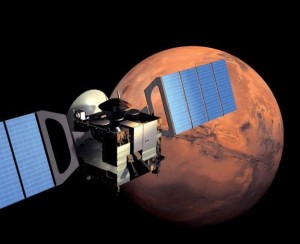By: Nicole Willett
 The latest episode of Neil DeGrasse-Tyson’s Star Talk, featuring, Bill Nye, President of The Planetary Society, Charles Bolden, NASA Administrator, and Astrophysicist, Dr. Michael Shara, was chock full of great information and insight. While watching, my heart ached for our civilization to understand the importance of a manned mission to Mars. Charles Bolden stated NASA’s plan is to be on Mars around 2030 with the current budget of half of one percent of the US budget, we believe with more resources and cooperation from various countries and private organizations we could be on Mars sooner and possibly cheaper. A major reason for needing a human touch on Mars is for exactly what Bill Nye stated which is that a human scientist could do in one minute the job that a robot does in a week, it’s about a ratio of 1:10,000. The problem was stated clearly by Dr. Michael Shara, “Frankly, we are not as brave as we should be.” These statements are extraordinarily important to be shared with the public. We are not as brave or as curious as we should be. Dr. Robert Zubrin, President of The Mars Society and one of the bravest men I have ever known, says we could be on Mars in ten years with the proper funding.
The latest episode of Neil DeGrasse-Tyson’s Star Talk, featuring, Bill Nye, President of The Planetary Society, Charles Bolden, NASA Administrator, and Astrophysicist, Dr. Michael Shara, was chock full of great information and insight. While watching, my heart ached for our civilization to understand the importance of a manned mission to Mars. Charles Bolden stated NASA’s plan is to be on Mars around 2030 with the current budget of half of one percent of the US budget, we believe with more resources and cooperation from various countries and private organizations we could be on Mars sooner and possibly cheaper. A major reason for needing a human touch on Mars is for exactly what Bill Nye stated which is that a human scientist could do in one minute the job that a robot does in a week, it’s about a ratio of 1:10,000. The problem was stated clearly by Dr. Michael Shara, “Frankly, we are not as brave as we should be.” These statements are extraordinarily important to be shared with the public. We are not as brave or as curious as we should be. Dr. Robert Zubrin, President of The Mars Society and one of the bravest men I have ever known, says we could be on Mars in ten years with the proper funding.
 Aren’t you curious? Is curiosity lost to our civilization for the most part? Some days I think it is. I often get asked this question, “What does The Mars Society do?” This question sometimes frustratingly comes from a place of condescension and rarely a place of curiosity. I have to remind myself that the work we are doing here is to take humans to another planet, an event that would change human history and that most people unfortunately have no concept of why it is so important. The short answer is: We are an advocacy group to promote the human exploration and settlement of Mars. Our goal is to educate the public through our Education Department, bring like-minded people together at chapter meetings and our annual conventions, and promote a human mission to Mars via projects and competitions. Sounds simple right? Well, not really. You see, people really like the societal pleasures of who is who, who is wearing who, what team are you for, what kind of car do you drive, what do you do for a living???? On and on this goes. Meanwhile, billions of people are left uninformed of what is really important: Curiosity, knowledge, and exploration. Instilling curiosity, providing access to true knowledge of scientific facts, and the goal of Mars exploration by humans, is an important part of what we are trying to accomplish.
Aren’t you curious? Is curiosity lost to our civilization for the most part? Some days I think it is. I often get asked this question, “What does The Mars Society do?” This question sometimes frustratingly comes from a place of condescension and rarely a place of curiosity. I have to remind myself that the work we are doing here is to take humans to another planet, an event that would change human history and that most people unfortunately have no concept of why it is so important. The short answer is: We are an advocacy group to promote the human exploration and settlement of Mars. Our goal is to educate the public through our Education Department, bring like-minded people together at chapter meetings and our annual conventions, and promote a human mission to Mars via projects and competitions. Sounds simple right? Well, not really. You see, people really like the societal pleasures of who is who, who is wearing who, what team are you for, what kind of car do you drive, what do you do for a living???? On and on this goes. Meanwhile, billions of people are left uninformed of what is really important: Curiosity, knowledge, and exploration. Instilling curiosity, providing access to true knowledge of scientific facts, and the goal of Mars exploration by humans, is an important part of what we are trying to accomplish.
 It is frustrating for sure, as a teacher of young people, to see that most are much more interested in the latest phone app than the intellectual curiosity for really learning anything. The way the educational system is set up is flawed and is partially responsible for the noninterest to learn. People do not enjoy memorizing things in order to take a test. People want to LEARN. Only learning can create critical thinking and curiosity, maybe this is the source of the apathy in America. I encounter some very curious minds, but sadly too few. Learning takes place with hands on experience and discussions, not workbooks and vocabulary lessons. We need to have a strong work force of critical thinkers, not robotic followers. The Apollo 13 Mission was not saved by people that had been able to get the highest SAT score
It is frustrating for sure, as a teacher of young people, to see that most are much more interested in the latest phone app than the intellectual curiosity for really learning anything. The way the educational system is set up is flawed and is partially responsible for the noninterest to learn. People do not enjoy memorizing things in order to take a test. People want to LEARN. Only learning can create critical thinking and curiosity, maybe this is the source of the apathy in America. I encounter some very curious minds, but sadly too few. Learning takes place with hands on experience and discussions, not workbooks and vocabulary lessons. We need to have a strong work force of critical thinkers, not robotic followers. The Apollo 13 Mission was not saved by people that had been able to get the highest SAT score  because they memorized a bunch of facts, those brave scientists were able to quickly and critically think and creatively solve a problem and save the lives of three brave men. The Mars Society is an organization that is involved in many projects that make an environment conducive to learning by hands-on experience and discussions, which lends itself to creativity and critical thinking. Going to the Moon took about 400,000 people, going to Mars will take many more. We need strong minded, willful, brave problem solvers to get to Mars.
because they memorized a bunch of facts, those brave scientists were able to quickly and critically think and creatively solve a problem and save the lives of three brave men. The Mars Society is an organization that is involved in many projects that make an environment conducive to learning by hands-on experience and discussions, which lends itself to creativity and critical thinking. Going to the Moon took about 400,000 people, going to Mars will take many more. We need strong minded, willful, brave problem solvers to get to Mars.
So, what does The Mars Society do to move this endeavor forward? Well, with a lot of patience and a group of very dedicated and passionate volunteers. The Mars Society was founded by Dr. Robert Zubrin in 1998, stemming from the Mars Underground which was started by Dr. Carol Stoker, NASA, Dr. Chris McKay, NASA, and Dr. Penelope Boston. The Mars Society is involved in many projects, including but not limited to: holding annual conventions, an Education Department for public outreach, STEM Education Events, Red Planet Pen (an educational blog), Red Planet Radio (podcast), a Speakers Bureau, having two analogue stations named Mars Desert Research Station and Mars Arctic Research Station, the University Rover Challenge and the Youth Rover Challenge.
 The Mars Society will convene the 18th Annual International Mars Society Convention on the campus of the Catholic University of America from August 13-16, 2015. The annual four-day event brings together key experts, scientists, journalists and policymakers to discuss the latest news on Mars exploration and efforts to promote a humans-to-Mars mission in the coming years. We have many notable speakers, including Dr. Robert Zubrin, President and Founder of the Mars Society, Apollo astronaut Dr. Harrison “Jack” Schmitt will give a plenary address, Dr. Deborah Bass, Deputy Project Scientist for NASA’s Mars 2020 rover, will discuss the planned exploration mission, Dr. Vint Cerf, Vice President and Chief Internet Evangelist for Google, will give a plenary talk about his long-term vision for solar system exploration and the role communications will play in this endeavor, Sam Scimemi, Director for International Space Station (ISS) at NASA Headquarters within the Human Exploration and Operations Mission Directorate, Dr. Pamela G. Conrad, an astrobiologist and mineralogist at NASA’s Goddard Space Flight Center and Deputy Principal Investigator for the Mars Science Laboratory (MSL) mission, will talk about the potential habitability of the planet Mars, and many, many more!
The Mars Society will convene the 18th Annual International Mars Society Convention on the campus of the Catholic University of America from August 13-16, 2015. The annual four-day event brings together key experts, scientists, journalists and policymakers to discuss the latest news on Mars exploration and efforts to promote a humans-to-Mars mission in the coming years. We have many notable speakers, including Dr. Robert Zubrin, President and Founder of the Mars Society, Apollo astronaut Dr. Harrison “Jack” Schmitt will give a plenary address, Dr. Deborah Bass, Deputy Project Scientist for NASA’s Mars 2020 rover, will discuss the planned exploration mission, Dr. Vint Cerf, Vice President and Chief Internet Evangelist for Google, will give a plenary talk about his long-term vision for solar system exploration and the role communications will play in this endeavor, Sam Scimemi, Director for International Space Station (ISS) at NASA Headquarters within the Human Exploration and Operations Mission Directorate, Dr. Pamela G. Conrad, an astrobiologist and mineralogist at NASA’s Goddard Space Flight Center and Deputy Principal Investigator for the Mars Science Laboratory (MSL) mission, will talk about the potential habitability of the planet Mars, and many, many more!
 The Mars Society has two analog research stations. One is the Mars Desert Research Station (MDRS) and the other is the Mars Arctic Research Station. Analog Research Stations are laboratories for learning how to live and work on another planet. Each is a prototype of a habitat that will land humans on Mars and serve as their main base for months of exploration in the harsh Martian environment. Such a habitat represents a key element in current human Mars mission planning. Each Station’s centerpiece is a cylindrical habitat, “The Hab,” an 8-meter diameter, two-deck structure mounted on landing struts. Peripheral external structures, some inflatable, may be appended to the hab as well. College students gain credit by living and working at the MDRS hab for two weeks at a time.
The Mars Society has two analog research stations. One is the Mars Desert Research Station (MDRS) and the other is the Mars Arctic Research Station. Analog Research Stations are laboratories for learning how to live and work on another planet. Each is a prototype of a habitat that will land humans on Mars and serve as their main base for months of exploration in the harsh Martian environment. Such a habitat represents a key element in current human Mars mission planning. Each Station’s centerpiece is a cylindrical habitat, “The Hab,” an 8-meter diameter, two-deck structure mounted on landing struts. Peripheral external structures, some inflatable, may be appended to the hab as well. College students gain credit by living and working at the MDRS hab for two weeks at a time.
The Mars Society Education Department maintains an educational forum website with resources free to all students, teachers and Mars enthusiasts. Opportunities for speakers, online or in person, are available to enhance students’ educational experience around the world. The Speakers Bureau of experienced Mars advocates can be contacted to speak and do a presentation and will either come to you or organize an online event for your group or class. The website also has an archive of blogs with a vast amount of information about Mars and the spacecraft that have visited the Red Planet. To enhance all educational materials, The Mars Society has a YouTube Channel that has hundreds of videos of talks from previous conventions. All of these resources are meant to stimulate minds and allow anyone to learn as much as they can about Mars and what a human mission to Mars entails.
 Chuck McMurray, the Mars Society’s Deputy Education Director, launched the Youth Rover Challenge in 2013 which is geared toward middle and high school students. The rover program consists of two levels of competition to get kids started earlier and also prepare them for participation in the University Rover Challenge held annually at MDRS in Utah. Grade levels 5 through 12 will be invited to compete in the Youth Rover Challenge. The University Rover Challenge (URC) was started in 2007 and run by URC director, Kevin Sloan. It is the world’s premier robotics competition for college students. Held annually in the desert of southern Utah in the United States, URC challenges student teams to design and build the next generation of Mars rovers that will one day work alongside astronauts exploring the Red Planet.
Chuck McMurray, the Mars Society’s Deputy Education Director, launched the Youth Rover Challenge in 2013 which is geared toward middle and high school students. The rover program consists of two levels of competition to get kids started earlier and also prepare them for participation in the University Rover Challenge held annually at MDRS in Utah. Grade levels 5 through 12 will be invited to compete in the Youth Rover Challenge. The University Rover Challenge (URC) was started in 2007 and run by URC director, Kevin Sloan. It is the world’s premier robotics competition for college students. Held annually in the desert of southern Utah in the United States, URC challenges student teams to design and build the next generation of Mars rovers that will one day work alongside astronauts exploring the Red Planet.
So, what does The Mars Society do? All of these things and so much more. We want the world to know the importance of a human mission to Mars. The reasons are many, but here are a few that can be found in our Founding Declaration:
We must go for the knowledge of Mars.
We must go for the knowledge of Earth.
We must go for the challenge.
We must go for the youth.
We must go for the opportunity.
We must go for our humanity.
We must go for the future.
Humans to Mars as a bridge to the stars…………..
[Image credits: NASA, Guardian, koolfm, NASA, CUA, TMS, TMS]






















